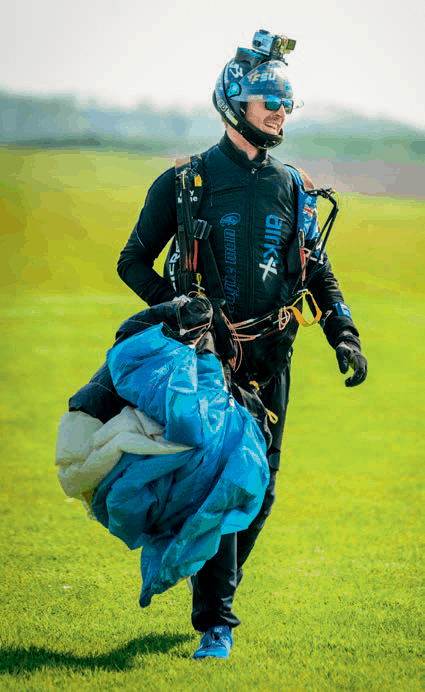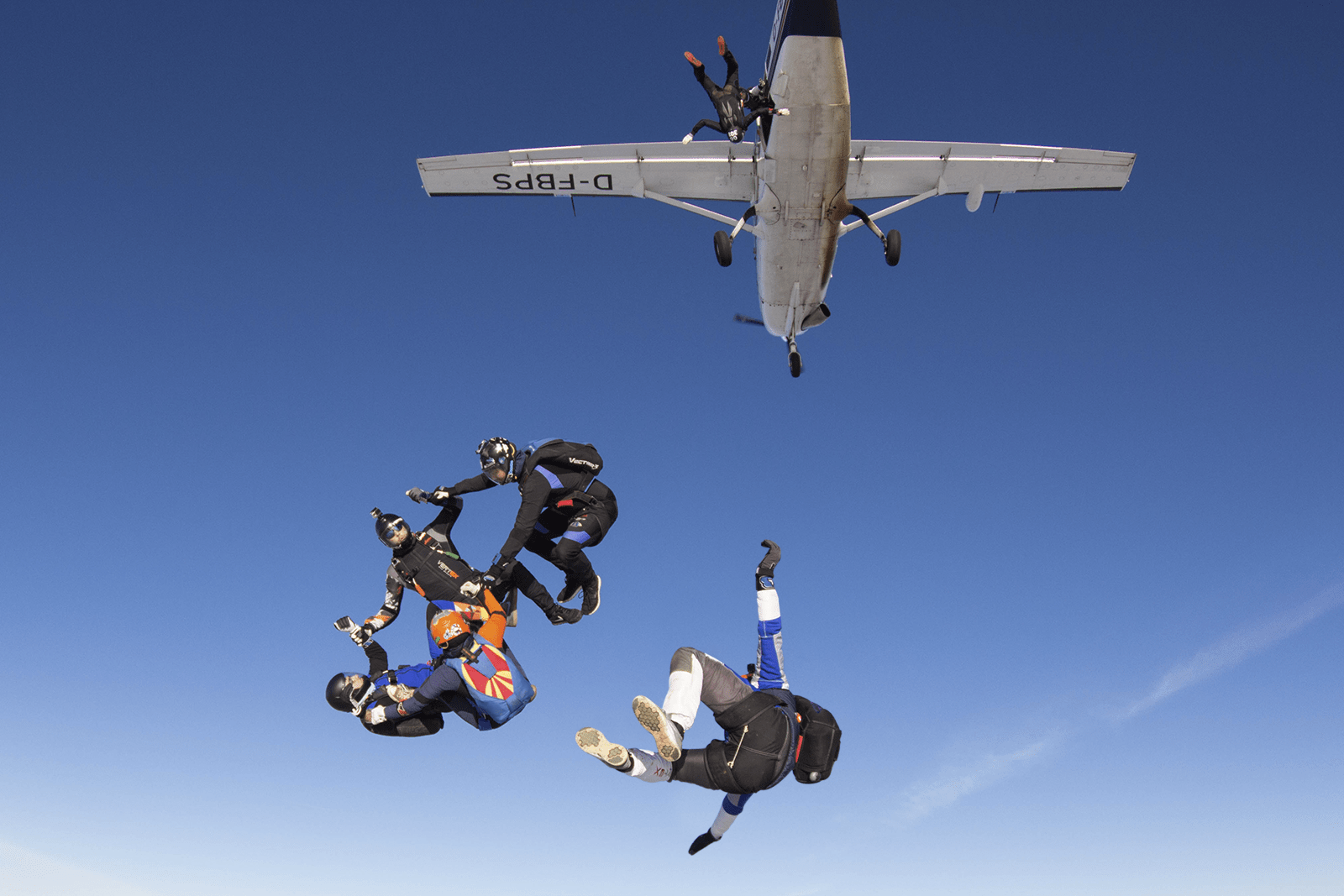Ally Milne shares some of the highlights from his Basic Freefly Coach Workshop.
What do you need to do to be a Basic Freefly Coach or BFFC? How much training is required, and what techniques and skills do our next generation of freeflyers need to know? These were all questions that the BFFC Workshop aimed to answer over a cold November weekend at Langar.
When coaches are given ratings without sufficient training it impacts their students’ ability to progress to their maximum potential. Giving the student maximum value is the key to building the next successful and safe generation of freeflyers.
Improving standards
Over the course of the BFFC Workshop, the participants were given theoretical and in-air tuition on what skills to brush up on to reach the required standard. The class had a full range of experience, from Accelerated Freefall Instructors to keen freeflyers looking for insight to prepare themselves for the 2020 season. The teaching was delivered in a relaxed tutorial style with lots of class participation, note-taking and question sessions. Each time I’ve run this workshop there have been coaches who are already qualified but felt they needed to level up their own knowledge and continue their own professional development.
The workshop included 12 sessions:
1. Introduction
Everyone introduced themselves, their experience and what they hoped to get from the course. Participants ranged from Accelerated Freefall Instructors (three of them) to interested jumpers who hadn’t yet met the jump number requirement, but wanted to know more.
2. What is a BFFC?
Introducing the development of FF progression in the UK, describing the role of a BFFC and updates to the renewal of coach ratings, and most importantly looking at who a BFFC
can coach.
3. Methods of Instruction
This much-sought-after lesson focussed on coaching and freefly techniques. Using real-world examples and anecdotes, it also guided participants on safeguarding when working in 1:1 situations. All participants finish with one portion of fruit in their possession, which reminds them that touch is the most important of all senses!
4. Qualities of a BFFC
Detailing and describing the key qualities of all 1:1 coaches, especially in relation to BFFC.
5. Equipment talk
What needs to be checked, and also ancillaries selection such as a suitable jumpsuit and audible altimeters.
6. Progression plans for FF1
What to teach, how to teach it and why we teach it. Using the EDIP structure learned in Methods of Instruction: Explanation – Demonstration – Imitation – Practice.
7. Exit techniques seminar
Discussion of the difficulty of HU exits, teaching core skills our students need to know, and how to launch HU formations when load organising.

8. Body position slide show
A lesson containing a large variety of people’s body positions from coach jumps, load organised jumps and videos. These demonstrated good positions, common errors and ugly situations that can occur. It is important to give the students the opportunity to explain what is going on, why it’s happening and how to correct.
9. Break off technique seminar
Detailing and breaking down the backtrack break off, why we use it and where to look. Also see How to Break off in the Feb 2014 Mag – check out britishskydiving.org/magazine-archive
10. Basic Risk Management
Introducing the incident pyramid, and discussing how we can stop the foundations being built.
11. Operations Manual knowledge
Participants learned about topics such as A Licence differences, opening heights and FF requirements. They also learned about the process of awarding an FF1, including getting an Advanced Instructor to award the sticker and different PTO processes with respect to this.
12. Load organising plans
Basic planning, common mistakes, and ideas for load organising small groups.
Luckily the next day the weather was clear but cold so we did some 8-way group jumps. Jump one was a belly jump working on flying with good discipline, then everyone transitioned to head up and followed the leader. Thereafter we worked on launching HU rounds and building HU skills, discipline and experience.
The weekend finished with some course participants ready to do evaluation briefs and jumps right away, others working on writing up lesson plan notes, and some working on in-air skills before coming back to be evaluated. The participants gave lots of positive feedback and even those who chose not to progress to the rating yet left with plenty of new knowledge and ways to think about things.
The question we should all ask from the new freeflyers’ points of view is: how much training do I want my coach to have received, and how qualified and experienced do I want the person that taught them?

British Skydiving requirements to become a BFFC
1. Qualifications
a) The recommendation of a CI
b) Hold FF1 or equivalent
c) A minimum of 300 freefall descents and three hours of freefall time
d) Two years involved in skydiving
e) Be at least a
i) Category System Basic Instructor, or
ii) Has attended a Sportscoach UK Course on ‘Coaching Methods and Communication’, or
iii) Has specific teaching or coaching qualifications, or
iv) Has attended a Methods of Instruction lecture, given by a Advanced Instructor, or
v) Has attended a Military Methods of Instruction Course
f) Is fully familiar with the current FF Manual.
2. Evaluation
Evaluation will be made by an Advanced Instructor who is a BFF or FF coach, or a BFF or FF coach nominated by an Advanced Instructor, or an FF1 or equivalent jumper of a proven high standard nominated by an Advanced Instructor and acceptable to the Safety & Technical Officer (STO) and/or Chief Operating Officer (COO).
3. Ground School Evaluation
This will include the full ground training phase of two complete FF1 levels, one of which should be a 1:1 and the other a group of three or four. All applicants are strongly advised to use video in their coaching programme.
4. In-Air Evaluation
This should be one of the 1:1 FF1 jumps, and should include the whole of the following:
i) The brief and dirt dive, from the twenty-minute point
ii) The climb to altitude
iii) The skydive where the Evaluator will make typical student errors
iv) The debrief
v) Logbook entries, which should include any corrective
training required.
5. The Evaluator’s Task
The ‘in air’ phase, as already stated, would include typical student mistakes. The candidate should not only be aware of these mistakes but should attempt to correct them in the air by use of signals or other means. On the ground the candidate should make good use of training aids and have a good coaching manner. The candidate should demonstrate a good knowledge of the basic principles of teaching and coaching.
Photo: Feature Image: Coaching Workshop jump at Skydive Langar by Chris Cook.
 By Ally Milne – British Skydiving Advanced Instructor
By Ally Milne – British Skydiving Advanced Instructor
Ally Milne is a full-time professional Instructor and Coach who is available to run skills camps worldwide and who has broken world records in FS, Head Down and Head Up. He would like to thank his sponsors, Performance Designs, United Parachute Technologies, Airtec, Cookie Composites, Larsen and Brusgaard and Vertex Suits, and you can contact him at allymilne@live.co.uk.
 First published in the April 2020 issue of Skydive the Mag.
First published in the April 2020 issue of Skydive the Mag.





